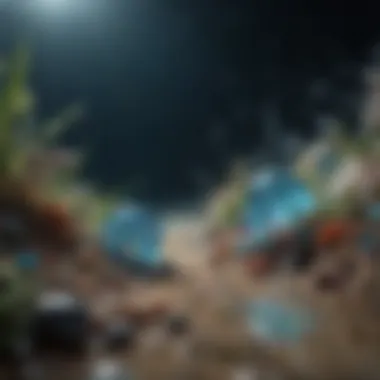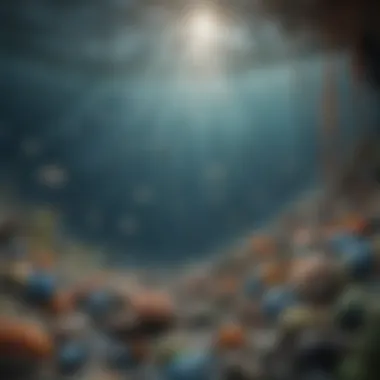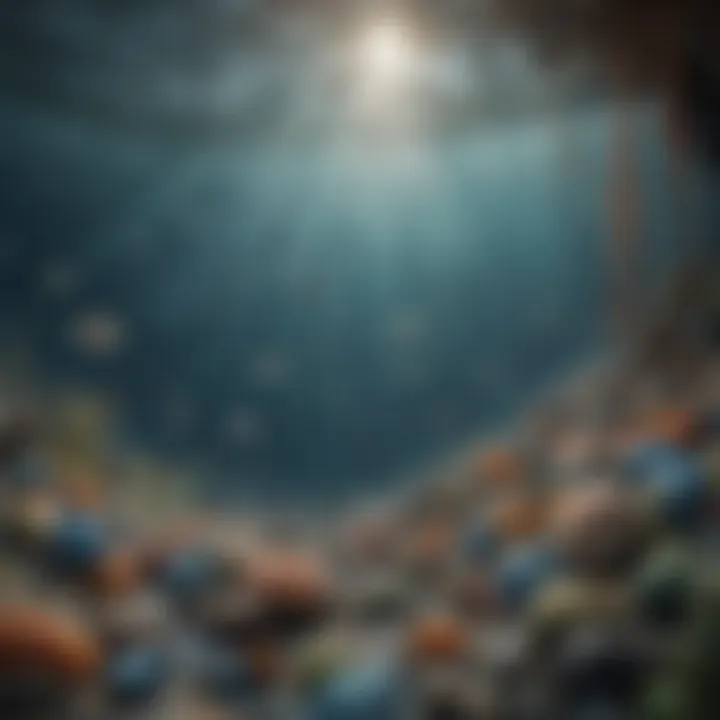Microplastics and Their Impact on Marine Ecosystems


Intro
Microplastics have come into the spotlight as a pervasive concern for marine ecosystems and the broader environmental tapestry. These tiny plastic particles, less than 5 millimeters in size, find their way into oceans and waterways, often going unnoticed. The reasons behind their proliferation are manifold, ranging from urban runoff to careless littering, and even industrial processes. The importance of understanding this issue cannot be overstated, as microplastics pose significant threats not only to marine life but also to human health and food security.
In the coming sections, the discussion will unfold in a systematic manner, focusing on several key areas: the sources of microplastics, their pathways into marine environments, their impact on marine biodiversity, and the wider implications for the food web and human health.
Recent Advances
In the complex web of marine ecosystems, recent advancements in understanding microplastics have shed light on some startling realities.
Latest Discoveries
Research has revealed that microplastics are more prevalent in oceans than previously believed. In particular, oceanic gyres—regions where currents converge—have become hotspot areas, accumulating substantial quantities of these particles. Studies indicate that certain species, such as filter-feeding organisms like oysters and mussels, are ingesting these microplastics directly, leading to potential health ramifications not only for the organisms themselves but also for the predators that consume them.
The mechanism of microplastic uptake has also attracted attention. A study published last year in the journal "Environmental Science & Technology" documented how microplastics can mimic the texture of natural food items, tricking marine species into ingestion. As a quote from a catchy research headline puts it,
"Plastics masquerading as food: The dark side of opulence in the ocean."
Technological Innovations
New technologies have emerged to track and analyze microplastics, allowing scientists to ascertain the extent of contamination in specific marine environments. The application of drones and remote sensing technology is gradually changing the landscape of how ocean pollution is monitored, making it easier to gather data on microplastic prevalence. Moreover, innovative filtration techniques are being developed to mitigate the release of microplastics from wastewater treatment facilities.
Technological strides such as machine learning algorithms are being designed to assist in predicting microplastic patterns based on environmental data, offering a proactive approach to manage this environmental scourge effectively.
Pathways of Microplastics
The journey of microplastics from land to sea is multifaceted. They originate from various sources, including:
- Cosmetics and Personal Care Products: Microbeads found in scrubs and toothpaste.
- Synthetic Fibers: Released during the washing of garments made from polyester and nylon.
- Industrial Waste: Particles released during production and manufacturing processes.
- Marine Activities: Fishing gear, plastic bags, and other debris that degrade into smaller pieces.
Understanding these pathways is crucial; it’s not just about identifying microplastics present in the ocean but also about comprehending how they infiltrate marine environments.
Impact on Marine Species
As microplastics permeate the marine ecosystem, various species face dire consequences. The assessment of such effects often reveals a grim scenario:
- Ingestion and Entanglement: Marine animals suffer not just from ingestion but also becoming entangled in larger plastic debris.
- Toxicological Effects: Microplastics can absorb harmful chemicals from the surrounding water, making them even more dangerous when ingested.
- Reproductive Effects: Research has indicated that certain ocean species experience reproductive challenges when exposed to microplastics, potentially disrupting population dynamics.
This is particularly alarming for endangered species such as certain sea turtles and seals, which rely heavily on marine flora and fauna as sources of nourishment.
Broader Consequences
The fallout from microplastic contamination reaches far beyond aquatic life. The food web is intricately tied, meaning that disruption at one level can reverberate throughout the entire ecosystem.
Natural food chains are increasingly under threat. From tiny zooplankton to the larger fish and mammals that prey on them, each link stands at risk. Ultimately, it’s humans at the top of the food web that stand to face the consequences—whether through direct consumption of contaminated seafood or through environmental degradation that affects fisheries and coastal economies.
Synthesizing Information
In concluding the discussion, it is clear that microplastics represent a significant threat to marine biodiversity and, by extension, human health. The ongoing research and technological innovations are encouraging, yet they cannot substitute for immediate action at both individual and policy levels. Raising awareness and adopting preventive measures are essential steps in confronting this pervasive challenge. The stripes of people trying to handle this issue can only grow stronger with increased collective efforts.
Prolusion to Microplastics
Microplastics have emerged as a significant concern within marine ecology. Although they may seem like small fragments of plastic, the implications of microplastics are vast and multifaceted, impacting ecosystems, marine species, and even the food chain. This article aims to dissect the various facets of microplastics, underscoring their definitions, origins, and prevalence in oceans. By delving into these elements, we can better appreciate the critical situation at hand and the urgency for action.
Definition and Origins
Microplastics are defined as tiny plastic particles less than five millimeters in size. They originate from two primary sources: primary microplastics, which are manufactured for specific industrial purposes like cosmetic exfoliants or industrial abrasives, and secondary microplastics, arising from the degradation of larger plastic debris. This degradation occurs through several natural processes, such as photo-degradation from sunlight or mechanical breakdown from ocean currents and wave action.
Understanding the origins of these particles is crucial as it allows for targeted strategies to mitigate their impact. For instance, an increase in the usage of biodegradable materials in consumer products could potentially minimize the production of primary microplastics at the outset. Knowing where these materials come from can certainly help in tackling them from a policy standpoint.
Prevalence in Oceans
The ubiquity of microplastics in marine environments is alarming. Current estimates suggest that millions of tons of microplastic waste can be found in the world's oceans. They are virtually everywhere, from the Arctic to the deepest ocean trenches. Areas known as gyres, where ocean currents converge, often accumulate high concentrations of microplastics, creating hazardous zones for marine life.
Research has shown that microplastics can be ingested by a range of marine organisms, from the smallest zooplankton to the largest whales. The sheer volume of microplastics in our oceans is staggering, with studies indicating that even remote areas are not immune to this pollution. A notable statistic is that nearly 80% of ocean plastics come from land-based activities, highlighting the widespread nature of this issue.
"Once microplastics enter the marine environment, they can be transported long distances, complicating efforts to contain and manage them."
In summary, understanding the definition, origins, and prevalence of microplastics provides a foundation for grasping the broader implications of their presence in oceans. As we advance further into this article, we will explore how they affect marine life, offering insight into the urgent need for awareness and action on this pressing issue.
Types of Microplastics
Understanding the different types of microplastics is crucial in the broader discussion of their impact on marine life and ecosystems. The classification of microplastics into primary and secondary types helps in identifying their origins, whether they are manufactured products or broken-down bits from larger plastic pollutants. Each type poses unique challenges and risks to marine environments, underscoring the need for targeted research and policies.


Primary Microplastics
Primary microplastics are the small plastic particles that are intentionally manufactured for various industrial and consumer applications. These particles often measure less than 5 mm in diameter and are used because of their specific properties. Common examples include microbeads found in personal care products like facial scrubs and toothpaste. These beads, while they may provide a scrubbing effect, have become notorious for washing down the drain and entering marine environments, where their impact is significant.
Aside from microbeads, primary microplastics also include industrial pellets, known as "nurdles," which are the raw material for producing larger plastic items. During production and transportation, these pellets can spill into waterways, leading to the proliferation of microplastics in marine ecosystems. The persistence of such plastics means that they can last for decades, creating a long-lasting issue for marine species that may mistake them for food.
The presence of primary microplastics raises numerous concerns:
- Ingestion by Marine Life: Fish and other marine organisms often ingest these particles, mistaking them for food, which can result in physical and biological harm.
- Chemical Contaminants: These primary plastics can absorb toxic pollutants from the environment, raising the stakes further when they enter the digestive systems of marine animals.
- Regulatory Challenges: The difficulty in controlling the production and dispersal of primary microplastics necessitates urgent policy measures to mitigate their impact.
"Primary microplastics are not just byproducts; they are part of a growing concern that invites deeper scrutiny into how our consumption habits affect marine environments."
Secondary Microplastics
Secondary microplastics result from the degradation of larger plastic items that break down into smaller fragments through environmental processes such as weathering, sunlight exposure, and physical disturbances. Plastic bags, bottles, and packaging may not vanish entirely; instead, as they age and are shredded by the elements, they devolve into microplastics.
This type of microplastic is often more concerning because it accumulates over time, continuously feeding into marine ecosystems. The fragmentation of larger plastic items means that the accumulation of these particles can be significant, presenting serious challenges:
- Ecosystem Disruption: As secondary microplastics infiltrate marine habitats, they disrupt food webs and impact biodiversity. Various species that play vital roles in marine ecosystems may face risks due to these particles.
- Potential Toxicity: Like primary microplastics, secondary varieties can also carry harmful chemicals. As they break apart, they expose surfaces that can harbor various toxic compounds, making their way up the food chain.
- Microplastic Distribution: Secondary microplastics can travel vast distances due to ocean currents, leading to widespread contamination across different marine regions.
The differentiation between primary and secondary microplastics is essential for researchers and policymakers. It allows for more strategic approaches in monitoring, managing, and ultimately reducing the microplastic crisis in our oceans. By identifying the specific sources and types of microplastics, steps can be taken to mitigate their effects on marine life while informing the public and stakeholders of the broader implications on our ecosystem.
Sources of Microplastics
Understanding the sources of microplastics is crucial to grasping their role in marine life degradation. These tiny pollutants, often invisible to the naked eye, originate from a plethora of industrial ongoing processes, consumer choice, and inadequate waste management practices. Highlighting the sources allows researchers, policymakers, and the general audience to see the broader picture of how human activities contribute to this environmental issue, paving the way for targeted solutions.
Industrial Processes
Many industrial processes inadvertently release microplastics into the environment. The production of plastic materials like polyethylene and polypropylene is a significant contributor. During manufacturing, tiny particles can come off either as pellets or degraded fragments, which, when mishandled, find their way into water systems. Notably, industries such as textiles introduce microplastics through the shedding of synthetic fibers. Washing machine discharges can release thousands of microfibers in a single load, often becoming part of the ocean’s ecosystem.
Moreover, plastic production facilities that don’t adhere to strict safety regulations often have leaky systems or improper disposal techniques, further exacerbating the problem. It’s essential for industries to adopt cleaner production processes and invest in technology that can minimize waste. By doing so, they not only reduce microplastic output but also uncover potential economic benefits through a cleaner production cycle.
Consumer Products
Everyday items are silently contributing to the microplastics crisis. The use of microbeads in many personal care products—like exfoliating scrubs and toothpaste—has become a notorious source. These small plastic beads, while marketed for their effectiveness, are washed down drains and eventually make their way to oceans. Additionally, products such as synthetic clothing release microfibers, as mentioned earlier, which are often too small to be filtered out by sewage treatment plants.
Household dust is another unseen agent. Items like synthetic carpets or furniture, age and release microplastic particles into the atmosphere, which eventually settle into water bodies through rainfall. This phenomenon highlights the importance of consumer awareness—choosing products with natural materials can be a step in the right direction. However, it is often challenging for consumers to identify such products without proper labeling.
Waste Management Practices
The state of waste management plays a significant role in microplastics proliferation. Inadequate disposal methods can lead to plastic debris ending up in rivers and oceans. Landfills, especially those lacking sufficient containment measures, can leak microplastics into the environment over time. The ocean is often a final resting place for many plastic items dumped irresponsibly.
Despite improvements in recycling technologies, many consumer plastics are still not recyclable. Statistical data reveals that less than 10% of plastic waste is recycled globally—indicative of a massive gap that needs filling. Transitioning to a circular economy, where materials are continuously repurposed, could alleviate some pressure. Investments in better waste management infrastructure, alongside public education campaigns, are crucial for mitigating this environmental dilemma.
"If we do not significantly address waste management, we risk unwittingly continuing this cycle of marine destruction."
By understanding these sources, it becomes evident that mitigating microplastic pollution necessitates a coordinated effort from all sectors, from industry players to everyday consumers. Each element—from production, consumption, to waste handling—represents a potential intervention point in this ongoing battle against marine pollution.
Transport Pathways in Marine Environments
Understanding the transport pathways of microplastics in marine environments is crucial for comprehending how these pollutants disperse and impact various ecosystems. Microplastics don’t just float around aimlessly; their movement is influenced by a combination of ocean currents, tides, and other environmental factors. This section aims to illuminate these transport mechanisms and underscore their significance in framing the broader conversation about microplastics and marine life.
Ocean Currents and Microplastics
The ocean is in constant motion, like a vast, swirling dance floor. Ocean currents play a pivotal role in determining where microplastics will end up after they enter the water. These currents can carry tiny plastic particles vast distances, often transporting them from populated coastal areas to remote locations like the depths of the Pacific Ocean.
- Types of Currents: The general patterns of ocean currents, including surface currents and deep-water currents, each have distinct effects on microplastic distribution. Surface currents, driven by wind and Earth’s rotation, tend to transport microplastics along coastlines, while deep-water currents can draw plastics down into the ocean’s depths.
- Gyres: Bigger currents can form gyres, areas where water circulates in large loops, becoming notorious for accumulating debris. The North Pacific Gyre, for instance, is home to the Great Pacific Garbage Patch, an area heavily laden with microplastics.
"Ocean currents act as highways for microplastics, dictating their paths through the marine environment, often leading them far from their original source."
Interaction with Marine Organisms
The journey of microplastics doesn’t stop at mere transportation; their interaction with marine organisms is much more alarming. As these particles drift through the oceans, they become part of the marine food web, leading to potential health issues for various species.
- Ingestion: Many marine animals, from tiny plankton to large whale species, mistake microplastics for food. This ingestion can result in physical blockages and malnutrition, compromising the health of animals at different levels in the food chain.
- Chemical Effects: Microplastics often carry harmful chemicals - whether additives from their original production or pollutants absorbed from the water. When ingested, these substances can leach into the tissues of marine life, leading to toxic effects that can disrupt reproductive systems or overall health.
- Habitat Disruption: Furthermore, these microplastics can alter habitats. For example, when they settle on the seafloor, they change the structure of habitats, impacting how organisms interact with their environment.
In summary, the transport of microplastics within marine environments is not just a matter of movement; it creates ripples of consequences through ecological systems, affecting various marine animals and potentially leading to long-term ramifications. Addressing these pathways is essential in devising effective strategies for mitigating microplastic pollution.
Effects on Marine Life
Understanding the effects of microplastics on marine life is pivotal in grasping the full extent of environmental degradation caused by human activities. As we delve into this matter, it becomes evident that microplastics not only pollute our oceans but also have significant repercussions on marine organisms' health and habits. The ingestion of these particles, direct interactions, and toxicological responses depict a grim picture of creatures once thriving in the seas. This section will dissect these implications in detail, highlighting how microplastics disrupt not only individual species but overarching marine ecosystems.
Ingestion of Microplastics


The act of ingestion of microplastics presents a complex layer of concern that must be thoroughly examined.
Impact on Fish
Fish are frontline victims of microplastics pollution, often swallowing these particles alongside their natural food. The intriguing aspect here lies in how varied the impact can be, depending on species and size. Fish like herring and mackerel tend to accumulate these substances, leading to both physical and physiological issues.
One notable feature is that microplastics can obstruct their digestive systems, creating a backlog of gut contents. This in turn can interfere with nutrient absorption, leading to malnutrition. Additionally, there have been documented instances of changes in behavior as a result of microplastic ingestion, such as altered feeding habits and reduced predator evasion. These impacts not only affect individual populations but ripple through the food chain, affecting larger predators and disrupting ecological balance.
Effects on Invertebrates
Invertebrates, particularly species such as shrimp and crabs, are often underestimated in their role in the marine ecosystem, yet they can be severely impacted by microplastics. The unique aspect about these creatures is that their small size often leads them to ingest microplastics without any distinction between food and debris. This creates a double-edged sword: while invertebrates are a fundamental part of the marine food web, they also act as bioindicators of ocean health.
The consequences include tissue damage, reproductive issues, and even increased susceptibility to diseases. Moreover, given their position at the base of the food web, the disturbances within their populations can result in significant setbacks for other marine species, amplifying worries regarding ecosystem integrity.
Consequences for Marine Mammals
Marine mammals are often seen as charismatic megafauna, yet they too are ensnared in the microplastics trap. The ingestion of microplastics can lead to critical health impacts for these animals, with specific attention needed for species such as seals and whales. Their feeding strategies expose them to microplastics, which can accumulate in their bodies over time, presenting a risk of lethal effects.
Interestingly, the unique feature of this concern is how these toxic materials can migrate up the food chain. Marine mammals, being apex predators, serve as a spotlight on the dangers of microplastic contamination. Beyond impacting individual health, such accumulations can compromise their reproductive success and impact population dynamics. The potential interferences with hormonal systems are especially alarming as they can lead to diminished offspring and future generations.
Toxicological Responses
Continuous exposure to microplastics can elicit complex toxicological effects in marine organisms, highlighting a critical facet of their influence in ecosystems.
Chemical Leaching
One peculiar aspect of chemical leaching is that microplastics are not inert; they can release harmful chemicals into the bodies of marine species. These chemicals can include additives used during manufacturing or environmental toxins that have adhered to microplastics over time. Such leachates can disrupt hormonal balance and result in neurological issues. This makes it a significant topic for deeper study, as understanding chemical leaching is fundamental in mapping out broader ecological damages.
Bioaccumulation and Biomagnification
Bioaccumulation and biomagnification represent alarming phenomena that emerge from microplastic consumption. As smaller organisms ingest these plastics, the toxins within them bioaccumulate, and when larger predators consume these smaller prey, the concentration of toxins magnifies through the food web. This escalation illustrates an underlying concern for marine biodiversity and can ultimately pose risks to human health as well. Marine species that are high on the food chain can end up with concentrated levels of toxins that originated from microplastics, thus making it not just an oceanic problem but a human one too.
The repercussions of microplastics on marine life are profound and multifaceted, necessitating urgent attention and action at both local and global levels.
Microplastics and the Food Web
Microplastics enter a vast marine system, where they weave a complex web of interactions that can disrupt the balance of life beneath the waves. Understanding the relationship between microplastics and the food web is crucial for grasping the implications of this pollution. These tiny particles not only affect the organisms that encounter them but can also ripple through various ecosystems, impacting larger predators and ultimately, humans.
The presence of microplastics in marine environments can hinder the health and survival of both small and large marine species. This phenomenon raises several critical considerations about how microplastics influence biodiversity, predator-prey dynamics, and even nutrient cycling within marine ecosystems.
Transfer of Microplastics through Trophic Levels
Microplastics make their way up the food chain through a series of interactions. Smaller marine organisms, like plankton, often mistake these particles for food. When these creatures ingest microplastics, they can suffer from physical obstructions or toxic effects, diminishing their fitness and survival rates.
As bigger fish consume these smaller organisms, they inadvertently absorb previously ingested microplastics. This bioaccumulation can lead to increasingly concentrated levels of microplastics in the bodies of larger marine species. The process can be outlined as follows:
- Plankton ingestion by small fish.
- Predation of small fish by larger fish.
- Potential transfer of toxins associated with microplastics through tissues.
dangers arise not just from the presence of the microplastics themselves, but also from associated chemicals that can leach into tissues, compounding the risk of harmful effects up the food chain.
Implications for Predators
The implications of microplastics for marine predators are concerning. Larger fish, seabirds, and marine mammals that are already dealing with the pressures of overfishing and habitat loss now face another layer of risk.
The consumption of microplastics not only reduces the fitness and health of these predators but can also affect their reproductive success and survival rates. For instance:
- Disruption of feeding behaviors: Predators may become less efficient at hunting due to dietary changes when their prey are impacted by microplastics.
- Nutritional deficiencies: Ingesting plastic does not provide any nourishment; thus, predators become increasingly susceptible to malnutrition.
Additionally, toxic substances attached to microplastics can lead to long-term health complications, affecting reproductive health and contributing to population declines. The cascading effects on the food web, ultimately impacting biodiversity, are significant. As researchers continue to unravel this complex issue, the need for effective monitoring and policy measures to mitigate these risks becomes ever more urgent.
Human Health Concerns
The omnipresence of microplastics in marine environments is not just an ecological tragedy; it has direct implications for human health that are becoming increasingly evident. As these tiny particles infiltrate marine ecosystems, they don't just pose risks to marine life; they also create pathways through which harmful substances reach humans. Understanding how microplastics affect us is paramount for developing effective public health strategies.
Consumption of Contaminated Seafood
When microplastics enter the oceans, they can be ingested by various marine organisms, from the tiniest plankton to large fish species that end up on our dinner plates. Ingesting microplastics can result in contamination of seafood, which raises significant health concerns for consumers. Fish and shellfish consume these particles, often mistaking them for food. This behavior not only affects the animals' health but also the safety of the seafood market.
Research indicates that some species, such as mussels and oysters, can accumulate microplastics and the harmful chemicals associated with them over time. As such, consumers of these seafood products may unintentionally ingest microplastics and their toxic companions, potentially leading to health risks that are still being studied.
- Key concerns include:
- Chemical Exposure: Microplastics can absorb toxins from the surrounding water, such as pesticides and heavy metals. When ingested, these pollutants may be released into the consumer’s body.
- Physical Effects: Ingesting microplastics can lead to physical issues, such as inflammation or damage to the digestive system, particularly in marine life. These impacts may be echoed in human health, as the effects are not fully understood.


Potential Long-term Health Effects
Long-term exposure to microplastics and their associated chemicals could have far-reaching implications for human health. Some studies suggest that persistent exposure might be linked to chronic health issues. While concrete evidence remains to be established, certain potential risks warrant attention.
- Some concerns include:
- Endocrine Disruption: Chemicals leaching from microplastics may interfere with hormonal systems, leading to conditions like infertility and developmental issues.
- Cancer Risk: Some compounds associated with microplastics are known carcinogens, raising concerns about long-term exposure and cancer development.
- Immune System Effects: Chronic inflammation caused by microplastics may weaken the immune response, making individuals more susceptible to infections and diseases.
"As we continue to consume seafood, we must consider the broader implications of microplastics. The implications not only affect the oceans but ultimately us as consumers."
In a world increasingly connected by what we eat, the ramifications of contaminated seafood extend beyond the table to the very fabric of human health. As scientific inquiries continue, it’s clear that addressing microplastic pollution must include a focus on human health implications.
The complexity of microplastics' impact underscores the need for an interdisciplinary approach, looking at environmental science, public health, and consumer behavior holistically. Stakeholders from various sectors must collaborate to mitigate these risks effectively.
Regulatory Responses and Policy Frameworks
In light of the growing crisis of microplastics in marine environments, regulatory responses and robust policy frameworks are becoming increasingly essential. This segment of the article explores the various layers of regulations designed to combat microplastic pollution. Understanding these frameworks is not just academic; it has real applications and implications for protecting marine life, which in turn, safeguards human health and food security.
International Agreements
On the international stage, a number of agreements have been established to tackle the challenges posed by microplastics. For instance, the Paris Agreement, while primarily focused on climate change, indirectly contributes to reducing plastic waste through sustainability initiatives. Furthermore, the International Maritime Organization has rolled out guidelines aimed at reducing marine pollution from ships, which explicitly includes microplastic discharge.
Moreover, agreements like the London Protocol focus on the prevention of marine pollution through dumping, addressing plastic waste management on a broader scale. These international pacts bring together nations to share best practices, foster innovation in waste reduction technologies, and implement stricter controls over plastic usage. By coordinating globally, these agreements amplify efforts and make it harder for any single nation to disregard environmental responsibilities.
"The oceans are the world's largest ecosystems, and effective governance is vital to keep them healthy."
National Policy Initiatives
At the national level, countries are enacting policies that specifically target microplastics. For example, in the United States, the Microbead-Free Waters Act prohibits the manufacture and introduction of personal care products containing plastic microbeads. Countries in the European Union are also taking commendable strides, enacting regulations like the Single-Use Plastics Directive, which aims to significantly reduce the consumption of various plastic products.
In addition, nations are increasingly putting forth waste management strategies that prioritize recycling and recovery rather than disposal. Many are investing in public education initiatives to raise awareness about the dangers of microplastics and engage citizens in clean-up efforts.
Some countries have even established monitoring programs that gather and analyze data on microplastic presence, promoting transparency and active adjustments to existing legislation. This localized focus can yield quicker results and provide citizens a tangible role in changing the narrative on plastic pollution.
In summary, both international and national frameworks exist not just as guidelines but as essential tools for preserving marine ecosystems. Without coordinated regulatory actions, the microplastics issue complicates the health of marine life, which is intertwined with the greater food web and human health outcomes.
Research and Monitoring Efforts
The need for robust research and monitoring efforts regarding microplastics is ever more pressing in today’s environmental climate. Understanding the dynamics of microplastics is essential for cultivating an awareness that can ultimately inspire meaningful action. The implications of this issue stretch across numerous disciples, including marine ecology, public health, and policy-making. By actively investing in research, we gain insights into the extent of microplastic pollution, its sources, and the far-reaching consequences on marine ecosystems and human health.
Current Research Trends
Recent studies focusing on microplastics reveal significant patterns. Researchers are utilizing advanced techniques like mass spectrometry and microscopy to accurately quantify microplastics and characterize their chemical makeup. This precision is necessary because the types of microplastics present can vary greatly, each potentially having different effects on marine life. For example, studies have shown a growing concern about the impact of microplastics on filter feeders, like bivalves. These organisms are at risk not only from ingestion but also from the toxic substances that can leach from plastics into their bodies.
Moreover, scientists are exploring geographical hotspots for microplastic accumulation, utilizing satellite data to track ocean currents and chart areas where microplastics are likely to concentrate. This evidential groundwork is critical for making informed recommendations for waste management and marine conservation efforts.
Key areas of focus include:
- Monitoring the distribution of microplastics across various ocean regions
- Assessing the biological impact on different marine species
- Examining the interactions between microplastics and pollutants
Future Directions in Research
The future of microplastics research must be multifaceted, encompassing innovative methodologies and interdisciplinary collaboration. One promising avenue is the integration of machine learning algorithms with existing data sets. This approach could allow researchers to predict patterns and trends in microplastic behavior over time. Such predictions might inform more effective pollution mitigation strategies.
Additionally, while much has been learned about the immediate effects of microplastics, there’s a pressing need to investigate chronic impacts. Longitudinal studies that follow specific species over extended periods could elucidate how microplastics influence reproductive success, growth rates, and population dynamics.
Collaboration across borders and disciplines will also be vital. Researchers must work together with governments, private companies, and NGOs to build a comprehensive framework of regulations that address microplastic pollution. Emphasizing public engagement and education will ensure that the solutions developed are sustainable and widely accepted.
In summary, the dedication to research and monitoring is critical. It equips us with the knowledge necessary to tackle the issue of microplastics head-on while offering a pathway to mitigate its devastating effects on marine ecosystems and beyond.
Mitigating the Microplastics Crisis
The issue of microplastics has been like a thorn in the side of marine ecosystems. Addressing this crisis is necessary for protecting not only marine life but also human health, since we are all part of the same web. This section will discuss various approaches to combat the ongoing problems posed by microplastics and outline the benefits of these solutions.
Innovative Solutions
A key approach in tackling the microplastics crisis is the development of innovative solutions. Researchers, environmentalists, and industry leaders have been working together to find edgy methods to minimize microplastics at their source and throughout their lifecycle.
- Improved Waste Management Systems
Implementing effective waste management practices stands at the frontline of prevention. Stricter regulations on the disposal of plastics can reduce the likelihood of them breaking down into microplastics. Local councils and municipalities can adopt advanced recycling technologies which might help separate out plastics more efficiently. - Biodegradable Alternatives
Companies are now in the race to design biodegradable materials that can replace traditional plastics. Such alternatives can decompose without causing harm to the environment, unlike their plastic counterparts, which can linger for centuries. - Aqua Formulation Solutions
Innovative solutions also extend to formulations used in personal care and cleaning products. Brands that promote 'microbead-free' products are becoming more common. These alternatives are not only better for the environment but also attract consumers who are environmentally conscious. - Ocean Cleanup Initiatives
Nonprofit organizations, like The Ocean Cleanup, are deploying technologies designed to physically remove existing microplastics from our oceans. Their innovative systems focus on concentrating and collecting floating plastics, thereby helping to cleanse marine environments.
Public Awareness Campaigns
Raising awareness around the issue of microplastics is crucial, as knowledge is often the first step toward action. Public awareness campaigns serve as the backbone of mobilizing communities, industries, and policymakers.
- Education Programs
Initiatives at schools and community centers can enlighten individuals about the hazards of microplastics. Engaging presentations, discussions, and practical workshops can help instill a strong understanding of the implications of plastic pollution. - Social Media Engagement
Campaigns utilizing platforms such as Facebook and Reddit can reach vast audiences. Viral content, such as informational videos or impactful infographics showing the plight of marine life due to microplastics, can stir emotional responses and encourage people to change their habits. - Community Cleanup Events
Organizing local beach cleanups not only cleans areas affected by plastics but also fosters a sense of community involvement and responsibility. Such events can be an opportunity for community members to learn about the far-reaching effects of microplastics while contributing to a cleaner environment.
"The biggest battle we face is not only cleaning our oceans but also preventing the problem from growing in the first place."
In summary, the path toward mitigating the microplastics crisis requires both innovative solutions and active public involvement. By bolstering waste management, promoting alternatives to plastics, and creating strong advocacy through awareness campaigns, it’s possible to significantly reduce the impact of microplastics on marine life and the broader environment.















